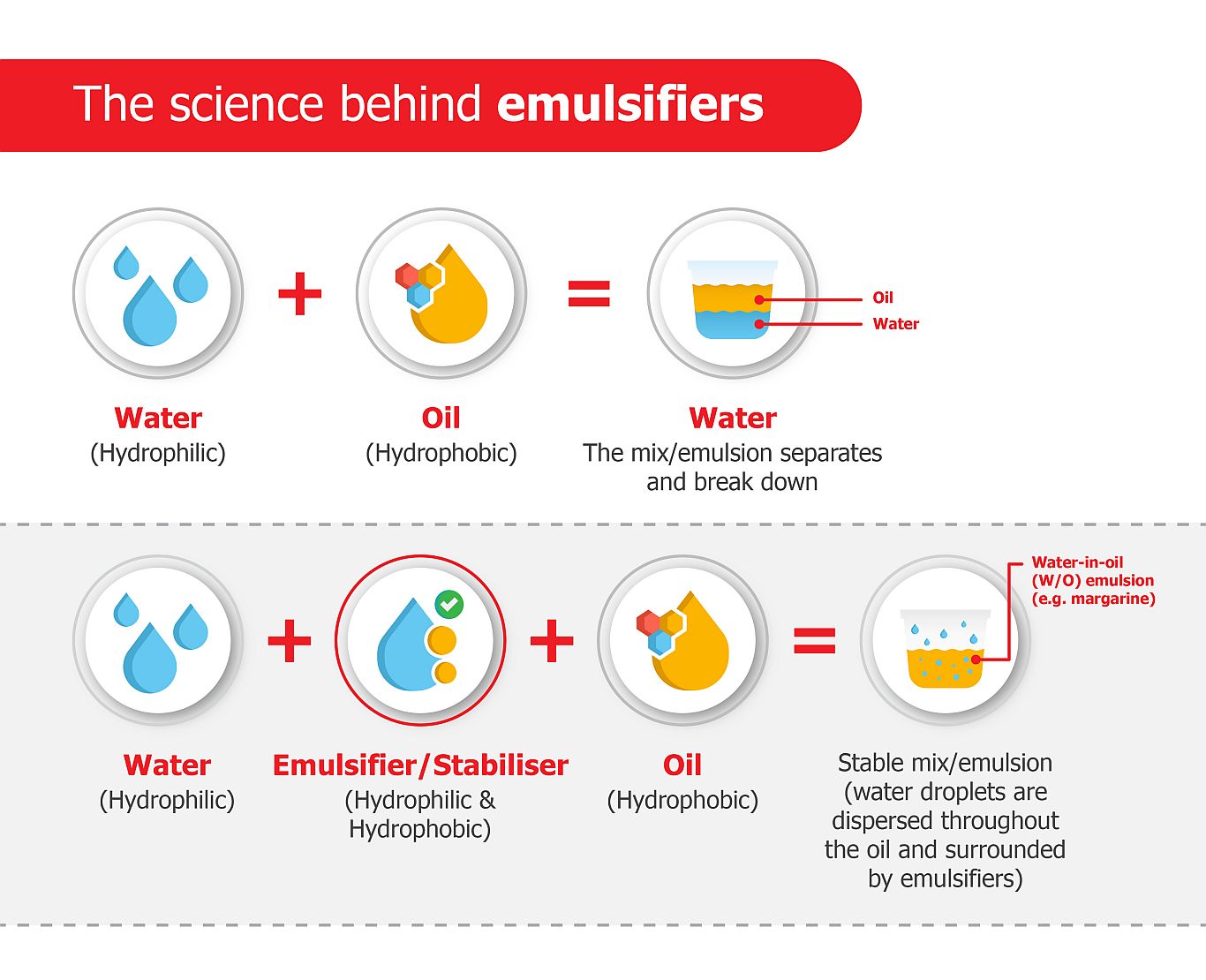Why It Is Necessary to Incorporate an Emulsifier in Food for Ideal Preference and Top Quality
Emulsifiers play an essential function in food production by making certain the secure mixing of immiscible liquids, such as oil and water. They reduce interfacial tension, which prevents the splitting up of ingredients and contributes to a consistent appearance. This not only improves mouthfeel however likewise affects flavor understanding. Recognizing the necessity of emulsifiers reveals much deeper insights right into their feature and relevance in culinary applications. What effects does this have for food advancement and customer preferences?
Recognizing Emulsifiers: The Basics
Emulsifiers play a necessary duty in food scientific research, acting as representatives that promote the mixing of two immiscible fluids, such as oil and water. These substances possess both hydrophilic (water-attracting) and hydrophobic (water-repelling) properties, which allow them to support emulsions. Common emulsifiers include lecithin, located in egg yolks and soybeans, and mono- and diglycerides, obtained from fats.
The Science Behind Emulsification
When two immiscible liquids are integrated, the process of emulsification ends up being essential for attaining a stable mixture. Emulsification entails dispersing one liquid within an additional, commonly oil in water or vice versa. This process happens with mechanical frustration, which damages the bigger beads right into smaller sized ones, therefore boosting the surface. Without the visibility of emulsifiers, these beads would coalesce, leading to separation.
Emulsifiers are particles with hydrophilic (water-attracting) and hydrophobic (water-repelling) buildings. Their one-of-a-kind framework permits them to lower the interfacial tension between both immiscible liquids, stabilizing the solution. This stabilization prevents splitting up and improves the uniformity of appearance and flavor. The interactions at the molecular level are vital for maintaining the integrity of the solution, ensuring that food items keep their desired consistency and taste. Comprehending this scientific research is considerable for food scientists and suppliers in creating high-quality food.
Kinds Of Emulsifiers Utilized in Food
The sorts of emulsifiers utilized in food can be extensively categorized right into artificial and all-natural ranges. Common food emulsifiers, such as lecithin and mono- and diglycerides, play an important function in improving food security and appearance. Understanding these distinctions is crucial for valuing just how emulsifiers contribute to the general quality of foodstuff.
Artificial vs. all-natural Emulsifiers
While both all-natural and artificial emulsifiers serve the important role of maintaining mixes in food products, their features and origins differ noticeably. All-natural emulsifiers, originated from plant or animal sources, consist of lecithin, casein, and certain gum tissues. They are often perceived as healthier alternatives, interesting consumers seeking clean-label products. In contrast, synthetic emulsifiers, such as mono- and diglycerides, are chemically crafted and may supply improved stability and functionality in a broader variety of applications. These artificial options can be extra cost-effective and offer constant top quality. They might stimulate uncertainty among health-conscious consumers. Eventually, the selection between artificial and natural emulsifiers relies on the preferred high qualities of the foodstuff, including structure, taste, and shelf-life stability.
Usual Food Emulsifiers
Emulsifiers play a vital duty in the food market, making certain the security and structure of various items. Usual food emulsifiers consist of lecithin, mono- and diglycerides, and polysorbates. Emulsifier In Food. Lecithin, acquired from sources like soybeans and egg yolks, is widely utilized in baked goods and delicious chocolates. Mono- and diglycerides, often acquired from veggie oils, enhance the creaminess of margarine and gelato. Polysorbates, synthetic emulsifiers, are often found in salad dressings and sauces, advertising a smooth uniformity. Other emulsifiers such as xanthan periodontal and guar gum, both natural thickeners, likewise add to the wanted texture in various foodstuff. Each emulsifier kind offers details purposes, adding to the general high quality and appeal of food items

Function in Food Security
Food stability is considerably influenced by the kinds of emulsifiers utilized, which help avoid the splitting up of active ingredients in various formulas. Emulsifiers such as lecithin, mono- and diglycerides, and polysorbates play necessary duties in preserving the uniformity of products like dressings, sauces, and gelato. Lecithin, originated from soy or egg yolk, is especially effective due to its natural properties, while mono- and diglycerides boost texture and service life. Polysorbates, on the other hand, boost the security of oil-in-water emulsions, making them optimal for baked items. The choice of emulsifier depends on the particular food application and wanted characteristics, ensuring that products remain steady, enticing, and of top quality throughout their intended service life.
Just How Emulsifiers Improve Structure and Mouthfeel
Enhancing the sensory experience of food, emulsifiers play a necessary role in boosting texture and mouthfeel. These substances help with the uniform distribution of components, allowing for a smoother and creamier uniformity in items such as dressings, sauces, and ice lotions. By supporting blends of oil and water, emulsifiers stop separation, resulting in a cohesive texture that boosts the total eating experience.
Emulsifiers can change the thickness of food products, adding to a desirable thickness or creaminess. This modification of appearance can influence exactly how food really feels in the mouth, affecting contentment and satisfaction. Furthermore, by developing a stable solution, see emulsifiers assist keep the honesty of the product, guaranteeing that the desired mouthfeel is consistently delivered in time. In general, the application of emulsifiers is crucial for achieving the ideal structure and mouthfeel, eventually elevating the top quality of food items.
The Role of Emulsifiers in Flavor Improvement
Taste improvement in culinary applications typically rests on the effective use emulsifiers. These substances assist in the blending of water and oil, permitting the even distribution of flavor substances within foodstuff. By creating secure emulsions, emulsifiers aid to envelop and release unpredictable flavors, boosting the general sensory experience.
On top of that, emulsifiers can boost the assumption of preference by affecting the mouthfeel and structure of dishes. A smoother, extra cohesive product can cause an enhanced understanding of flavors, making them a lot more pronounced and pleasurable. Emulsifiers can protect sensitive flavors from destruction, ensuring that they continue to be undamaged throughout processing and storage space.
Emulsifiers in Popular Food Products
How do emulsifiers add to the structure and stability of popular foodstuff? Emulsifiers play an essential role in numerous commonly consumed items. In salad dressings, they guarantee a smooth blend of oil and vinegar, protecting against separation and enhancing mouthfeel. In ice lotion, emulsifiers produce a creamy texture by supporting air bubbles, leading to an indulgent and abundant item. Baked goods, such as bread and cakes, take advantage of emulsifiers by improving volume and crumb framework, causing a lighter and extra attractive texture. In addition, mayonnaise counts on emulsifiers to keep its thick uniformity and prevent oil splitting up. Margarine and spreads additionally make use of emulsifiers to attain a spreadable appearance while keeping stability. These instances highlight the considerable influence of emulsifiers on the top quality and pleasure of daily foodstuff, highlighting their significance in modern-day food formula.
The Future of Emulsifiers in Food Innovation
The future of emulsifiers in food development is marked by significant improvements in innovation, leading the way for brand-new formulas. In addition, the demand for much healthier emulsifier options is rising, triggering scientists to explore natural and plant-based choices. Lasting sourcing techniques are also coming to be important, as customers progressively prioritize environmental obligation in their food selections.
Developments in Emulsifier Innovation
As scientists remain to check out the molecular complexities of emulsifiers, considerable improvements are arising that promise to change food technology. Recent developments concentrate on creating much more versatile and effective emulsifiers that enhance structure, stability, and flavor in various foodstuff. Advancements in biopolymer-based emulsifiers are gaining grip, providing improved sustainability and efficiency over standard choices. Furthermore, advancements in nanotechnology are making it possible for the style of emulsifiers at the molecular degree, which can cause finer emulsions and enhanced sensory experiences. These technological innovations are not just boosting item quality but likewise expanding the array of applications for emulsifiers in the food industry. As these advancements unravel, they are expected to redefine culinary possibilities and consumer choices in the future.
Healthier Emulsifier Alternatives
While traditional emulsifiers have played an essential function in food production, there is an expanding demand for healthier choices that line up with customer preferences for natural active ingredients and tidy tags. Innovations in plant-based emulsifiers, such as those derived from flaxseed, soy, and sunflower, have gained popularity due to their viewed health advantages. These alternatives frequently contain fewer ingredients and use capability comparable to synthetic emulsifiers. In addition, components like aquafaba, the fluid from prepared chickpeas, have emerged as versatile emulsifying representatives, interesting vegan and health-conscious customers. Emulsifier In Food. The change in the direction of these much healthier emulsifiers not only enhances the appeal of food but likewise sustains the pattern of transparency in ingredient sourcing, ultimately fostering consumer trust fund and satisfaction

Lasting Sourcing Practices
Lasting sourcing techniques are coming to be increasingly vital in the advancement of emulsifiers, mirroring a check out here wider dedication to ecological duty within the food industry. Manufacturers are currently focusing on the usage of renewable energies, such as plant-based ingredients, which decreases the carbon footprint related to standard emulsifiers. This change not only supports biodiversity yet also promotes read here ethical farming practices that benefit local areas. Additionally, innovations in innovation make it possible for the extraction and processing of emulsifiers with minimized ecological influence. By adopting lasting sourcing, firms enhance their brand image while fulfilling customer demand for transparency and eco-friendliness. As the food market proceeds to evolve, the integration of sustainable emulsifiers will certainly play an important duty fit future advancements, ensuring a balance in between top quality and ecological stewardship.
Frequently Asked Questions
Are Emulsifiers Safe for Individuals With Food Allergies?

Can Emulsifiers Influence the Nutritional Value of Food?
Emulsifiers can affect the dietary value of food by improving vitamins and mineral absorption or potentially changing the bioavailability of certain compounds. Nonetheless, their results differ commonly depending on the kind of emulsifier and the overall food formulation.
Exactly How Do Emulsifiers Impact Life Span of Products?
Emulsifiers enhance the life span of products by supporting blends, preventing separation, and decreasing wasting. This stability helps keep texture and flavor gradually, ultimately ensuring food remains attractive and safe for longer periods.
What Prevail Natural Emulsifiers Discovered in Home Kitchens?
Usual all-natural emulsifiers discovered in home kitchens consist of egg yolks, soy, mustard, and honey lecithin. These active ingredients assist stabilize mixes by decreasing surface tension in between oil and water, enhancing appearance and consistency in numerous dishes.
Exist Any Kind Of Worry About Artificial Emulsifiers in Food?
Worries concerning synthetic emulsifiers in food include prospective digestive concerns, inflammatory feedbacks, and web links to weight problems. Some studies recommend these additives might interfere with digestive tract microbiota, increasing questions regarding their long-lasting effects on health and wellness and wellness.
Typical food emulsifiers, such as lecithin and mono- and diglycerides, play a vital function in boosting food security and appearance. Emulsifiers play an essential function in the food industry, guaranteeing the stability and structure of various products - Emulsifier In Food. Various other emulsifiers such as xanthan gum and guar gum tissue, both all-natural thickeners, likewise contribute to the desired texture in numerous food items. Current developments focus on producing more functional and reliable emulsifiers that boost texture, security, and taste in numerous food products. Emulsifiers can position risks for individuals with food allergies, as some emulsifiers are derived from irritants like soy or eggs